Artnet News Pro
Brussels Is Home to Some of Europe’s Most Dedicated Art Collectors. Find Out Which One Bought What at the City’s Top Art Fair
For its size, Brussels has an outsized number of serious art collectors.
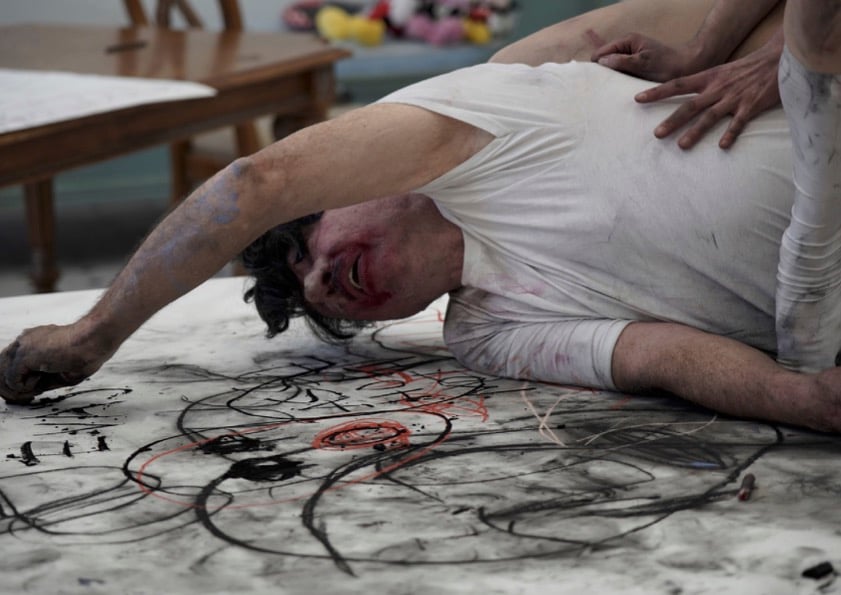
For its size, Brussels has an outsized number of serious art collectors.

Art Brussels, held April 28 to May 1, welcomed a crowd still travel-tipsy from the Venice Biennale, but enthusiastic to meet at the fair’s first in-person event in two years. Hosting 157 participants from 26 countries, the event was broken up by more than 30 immersive solo-artist booths, a resounding favorite among visitors.
“People are hungry for art and excited to be back,” said Kamiar Maleki, director of Volta Art Fairs, who attended the Art Brussels opening. “It’s a fresh fair that supports young artists and young galleries—the Discovery section is full of exciting, outside-the-box art, and you have fantastic collectors here.”
The fair also drew a direct line to Venice, with an exhibition called “L’Oeuvre et son Double” highlighting artists whose work could be seen in both places. It included pieces by Ignasi Aballí, Francis Alÿs, Mirella Bentivoglio, Mariana Castillo Deball, Solange Pessoa, and others. Indeed, several collectors at the fair said they hoped to acquire works by artists showing in Venice.
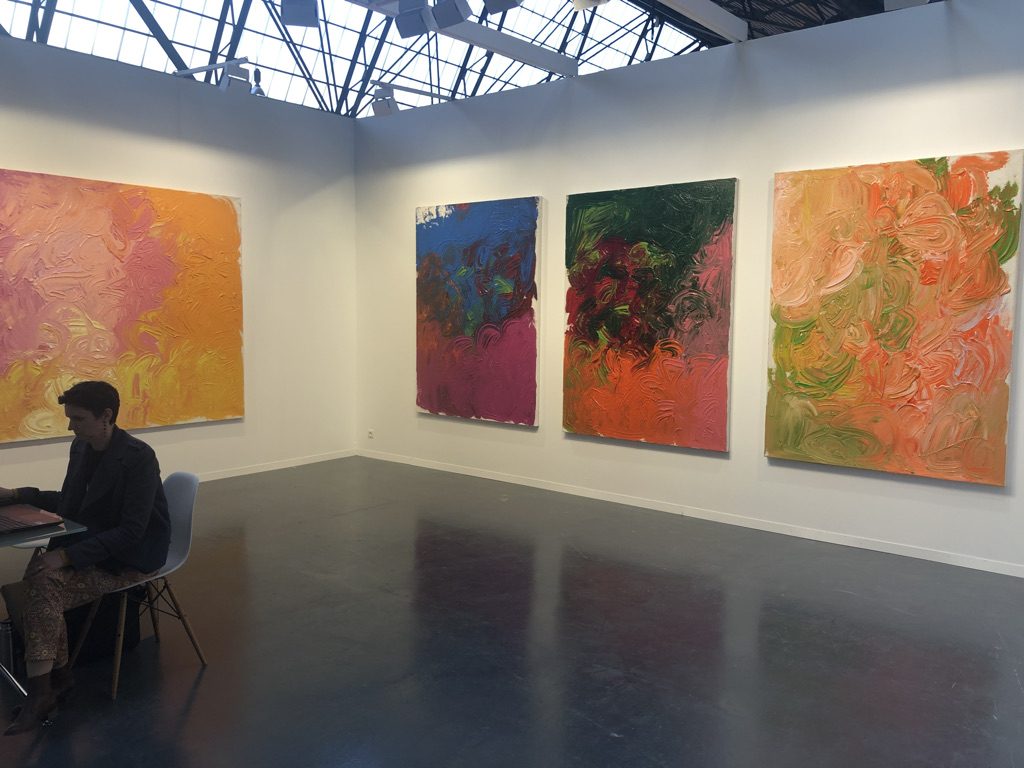
Galerie RX had a solo show of colorful works by the late artist and leader of Viennese Actionism Hermann Nitsch
But not everyone was on the hunt on opening day. “I spent more time talking to people than looking at art the first day, so I have to go back. People were really happy to see each other,” said collector Frédéric de Goldschmidt. He recently founded Cloud Seven, an exhibition, co-working and living space in Brussels that includes works from his personal collection installed across seven floors.
For its size, Brussels has an outsized number of serious art collectors, estimated in the hundreds, though there’s no official count, a fact which most attribute to lower taxes and a less centralized government that tends to motivate private initiatives. Along with that comes a wealth of top-notch galleries of eclectic sizes and programs.
“Belgians are historic collectors,” said the fair’s managing director Anne Vierstraete. “There’s a huge knowledge and interest in art, and the DNA of the fair needs to align with that. The art you see here is less represented in the very commercial, bigger art fairs. You cannot show the stuff that has already been shown in different art fairs, because people expect something else, a surprising, new element,” she added.
With housing costs relatively low (compared to Paris, for instance) collectors have more room to spread out, often opening their spaces to the public during Art Brussels, or longer. For the same reason, artists can more feasibly afford to live in the European capital, all contributing to a vibrant art scene, particularly visible on Gallery Night, before the fair opening.
I got a taste of the gallery-hopping event with my sister, the Los Angeles-based artist Mimi Lauter—whom, full disclosure, also had a solo presentation with the Brazilian gallery Mendes Wood DM at the fair and inspired me to cover the event for Artnet News. As teens, she and I used to take the bus to look at art in San Francisco and managed to make it to Europe a little later for more of the same. I can still remember those early, transcendental explosions we experienced at shows then, boosted by mocha lattes at too young an age.
After running into Mimi’s friends from Los Angeles outside Xavier Hufkens’ Wyatt Kahn show—like many visitors in Brussels that week, they had all just arrived, still wobbly from Venice—we made our way to the Heidi Bucher exhibit at Mendes Wood DM’s Brussels gallery space.
The Bucher show was an awakening jolt to the senses. The long under-recognized Swiss artist and feminist, known for her latex “Skinnings” of homes, also has a large traveling retrospective currently at the Kunstmuseum Bern. Her “Skinnings” sometimes hang freely, almost like laundry, letting light seep through, and always coming into their own leathery, strange life. With the peeled remnants of walls, doors, decorative molding, varying shades of paint and floors, Bucher captured and duly transformed these social and architectural containers of our lives.

Installation view of a solo show dedicated to the Swiss artist Heidi Bucher, at Mendes Wood DM, Brussels. Photo: Kristien Daem. Courtesy of The Estate of Heidi Bucher and Mendes Wood DM, São Paulo, Brussels, New York.
In short, there is a lot to see around Art Brussels that deserves more time and attention. From the Wiels Contemporary Art Center, The Royal Museums of Fine Arts of Belgium with contemporary shows featuring Omar Ba and Tanya Goel, private collections open to the public, plus foundations, the fair itself is only one aspect of the city’s thriving artistic landscape.
“I told people they can stay three or four days here, no problem. You’re going to see great art,” said Alain Servais, who shows his collection in curated exhibits at The Loft, where he lived from 2000 to 2010, and now runs a residency and exhibit space. “From the Clearing’s amazing show of artist Neil Beloufa to Xavier Hufkens, we have 13 artist-run spaces, which is more than in London,” Servais said. “We also have the biggest concentration of true collectors—people who buy more than 15 to 20 works every year, with all different points of view,” he said. “For me, an interesting collection is when I don’t know 50% of the names.”
Elena Soboleva agreed that Brussels has a uniquely active and close-knit community of collectors. In 2016, she co-founded The Embassy with her husband Ronald Rozenbaum, in their home. The former Lebanese embassy building now contains their private collection and hosts exhibitions on occasion. Soboleva co-curated the current show, “Prism Shift,” on view until May 8, featuring four artists from the Städelschule in Frankfurt, Germany.
“There’s more of a culture here where you aspire to open up your collection, and you feel more able to do so, than in the US, for instance, where you might not feel like it’s worth showing your home unless you have a mega-collection,” reasoned Soboleva, who is also Global Head of Online Sales at David Zwirner gallery in New York, where she lives part of the time.“Here [in Brussels] I think people are just interested in how others engage with art, support and live with it in a different way,” she added.
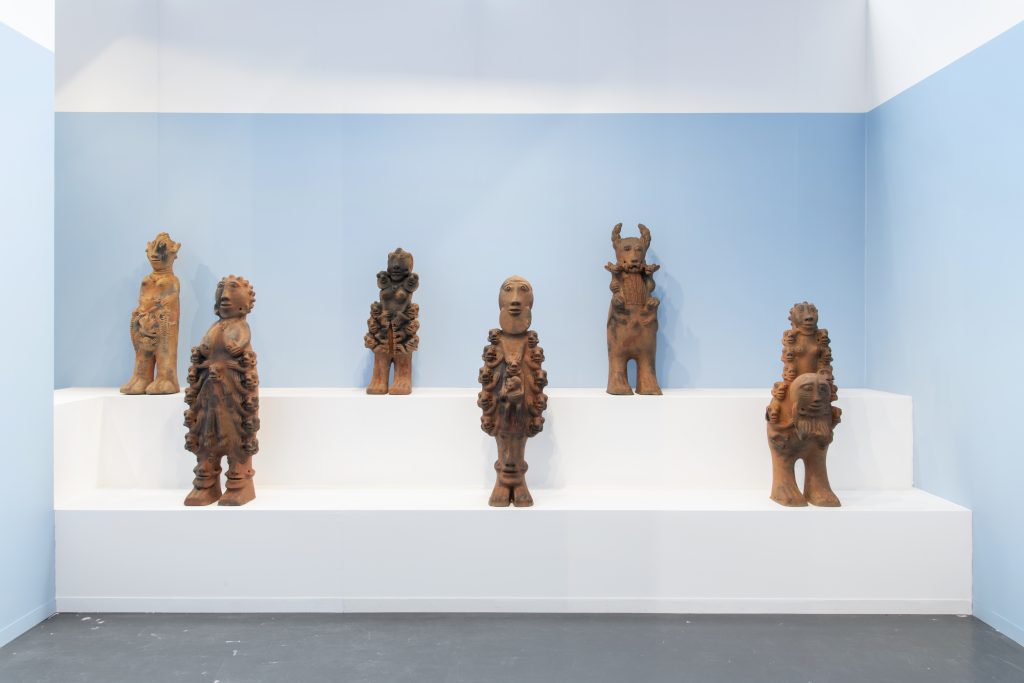
Seyni Awa Camara’s solo presentation with Baronian, at Art Brussels 2022.
The couple’s collection includes pieces by Dan Flavin, Sherrie Levine, Bruce Nauman, Laure Prouvost and Alex Ayed. Their library of catalogs and 60s ephemera is a highlight of their space, with treasures like Lucy Lippard postcards, or another postcard shot through with a BB gun by Gordon Matta Clark. “Brussels has this history of amazing collectors who have supported conceptual art and really-difficult-to-collect art from the 1960s, when Americans were not buying it. They didn’t quite understand it,” Soboleva said.
Space is also more affordable in Brussels, noted the French-born collector Frédéric de Goldschmidt. “I would never have been able to show as many works of my collection in Paris,” he said. “Brussels is a city that is a little chaotic. It includes very different ways of living, and a state that is very decentralized, which leaves a lot of room for local initiatives, due to a very weak budget compared to other European cities,” de Goldschmidt added. “In the end, it functions.”
Still, it’s harder to determine how many of the city’s collectors were buying at Art Brussels this year. Galleries said international collectors came from nearby France, Spain, Germany and Luxembourg, and while sales seemed to be strong at the fair, for some, the platform can serve more as a networking hub. “For me, an art fair is a social event where everybody is in the same place at the same time, available to talk. That’s 60% to 70% of the reason I go,” Servais said.
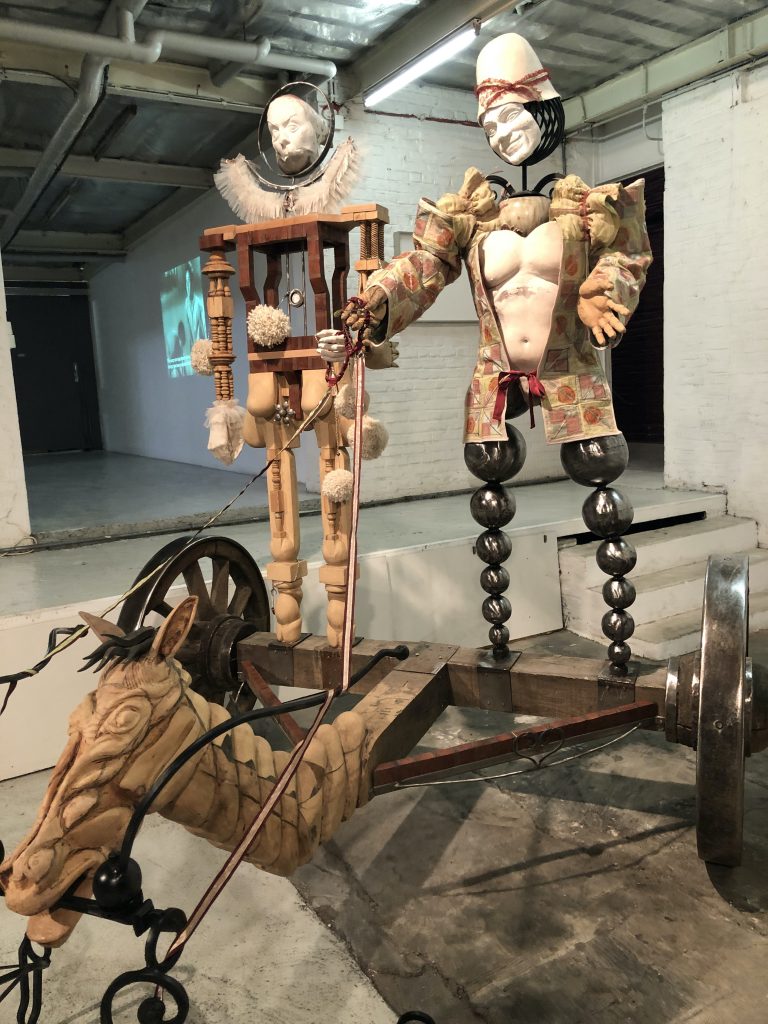
Nils Alix-Tabeling, Together at Last!… Peirrot & Harlequin, in a rural fantasy (2020-21), on view at the Servais Family Collection, The Loft, in Brussels.
“There’s also a silly system now, where everybody gets the previews before the fair, which means that anything that is a little bit in demand is sold before the opening,” he added. Nevertheless, he was happy to discover the solo booth of Noel W. Anderson at Zidoun-Bossuyt, showing tapestries of skewed images of basketball players. “That was something daring,” he said, noting the artist was invited to join the Berlin Biennale this year.
Another highlight was Galerie Les Filles du Calvaire’s solo booth of works by French Guadeloupean artist Kenny Dunkan, who is in a group show at the Reiffers Art Initiative in Paris, where he participated in a mentorship program with US artist Rashid Johnson. Enlarged, blurred images of Vallauris ceramics covered the booth’s walls, coming into focal points in the form of sculptural images of the same, lava-like pottery. Digitally printed onto several stacked layers, creating the glazed, uneven textured surface of ceramics, several of the prints sold early, for €9,000 each. But his larger, more ambitious, autobiographical sculptures combining design, folkloric and industrial elements (priced between€20,000 and €40,000), were still unsold by the end of the fair.
“Belgian collectors are effectively passionate and ready to take risks, but perhaps not yet for Kenny’s larger pieces, and we are waiting for imminent, imminent, imminent decisions,” regarding their purchase, said Stéphane Magnan, the gallery’s associate director.
Other highlights included the immersive Stefan Vogel solo show at Munich gallery Jahn and Jahn, Paul McCarthy’s solo exhibit of recent drawings at Xavier Hufkens, and Zeno X Gallery’s presentation, including works by emerging artist Pélagie Gbaguidi, among others. Easy to miss, but a happy discovery were the poetic sculptures of young Belgian artist Babs Decruyenaere, priced between €1,250 and €2,850.
The solo shows tended to sell particularly well, according to many galleries who spoke to Artnet News. Sold-out booths included Clearing gallery’s presentation of works by Koenraad Dedobbeleer, and Galerie Templon’s of Abdelkader Benchamma (works priced €4,000 to €45,000), while Baronian sold almost all of their large, Solo Prize-winning booth of ceramic sculptures by Seyni Awa Camara (priced €6,000-€35,000).
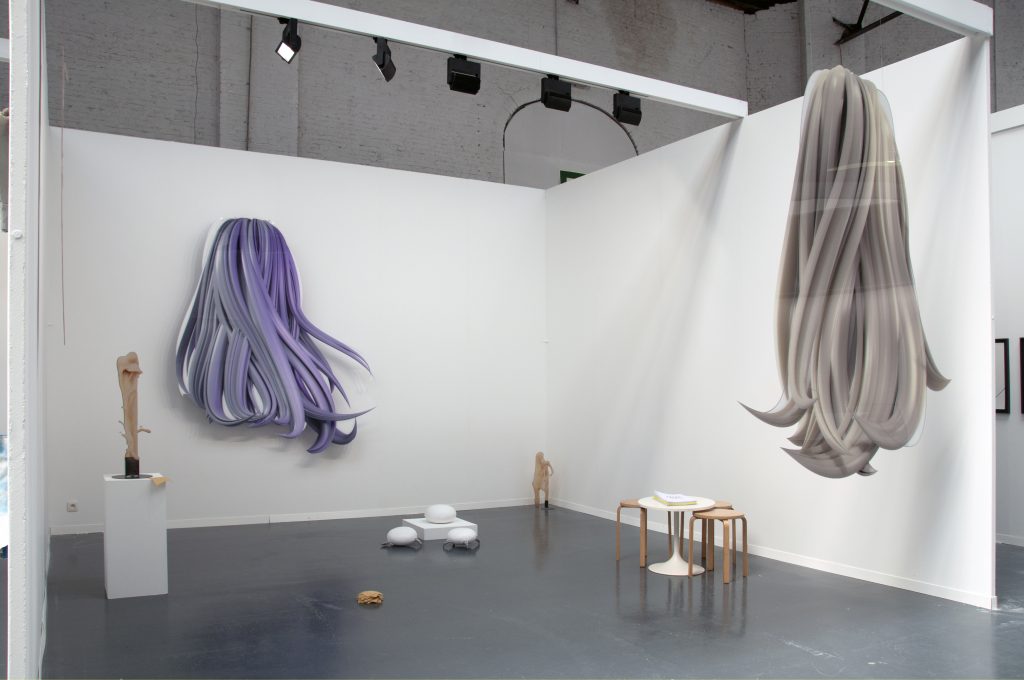
The installation “F.A.T.A.L” by the duo Momu & No Es at Joey Ramone and House of Chappaz collaborative booth won the Discovery Prize at Art Brussels 2022.
Elsewhere, a special Discovery Prize for the best booth was awarded to House of Chappaz and Joey Ramone, for their collaborative presentation “F.A.T.A.L.”, featuring works by the artist duo Momu & No Es. They imagined a world of the future, if the pandemic were to continue (prices ranged from €7,500 to €10,000).
And at another Discovery section gallery, Wouters Waldburger, the young South American artist Elen Braga invited visitors to sit across from her and jointly crochet a tapestry using colorful strips of silky fabric. It was less about the result of their shared creation, she said, and more of “a way to start up a conversation.” Her show, “The Horses Are Coming,” is on view at the gallery’s space in Brussels.